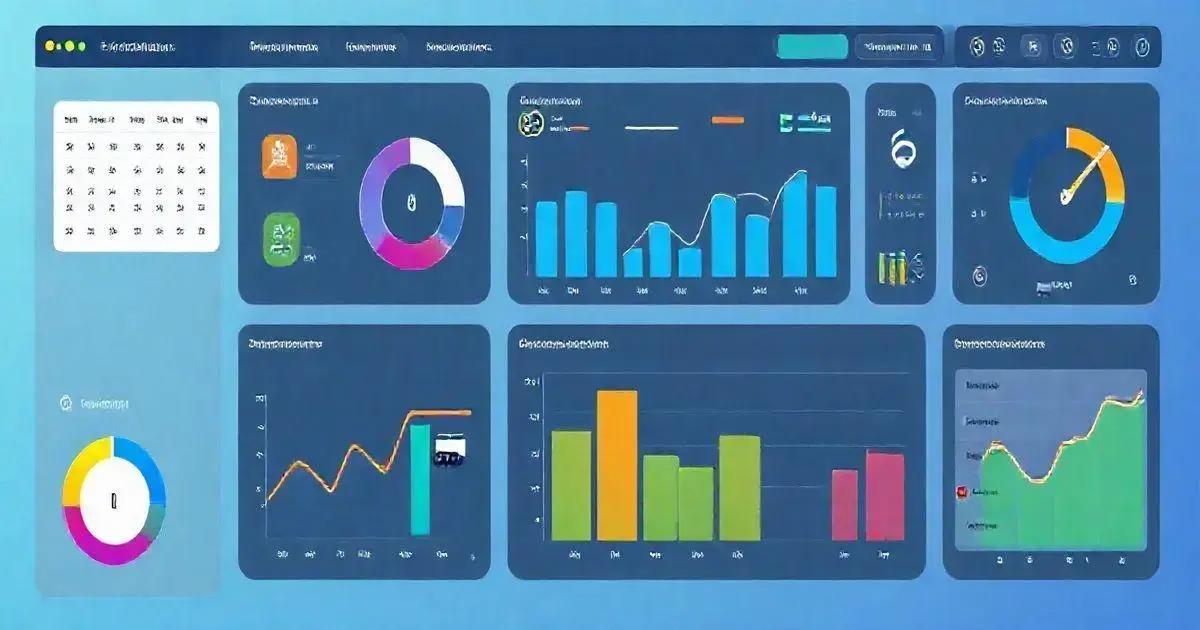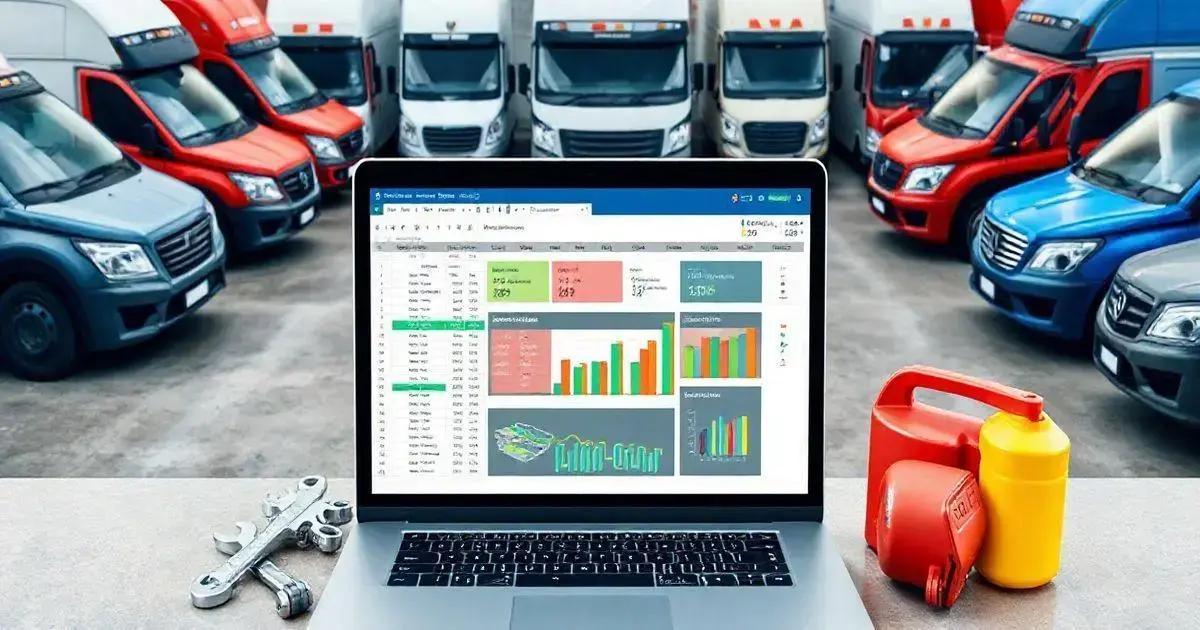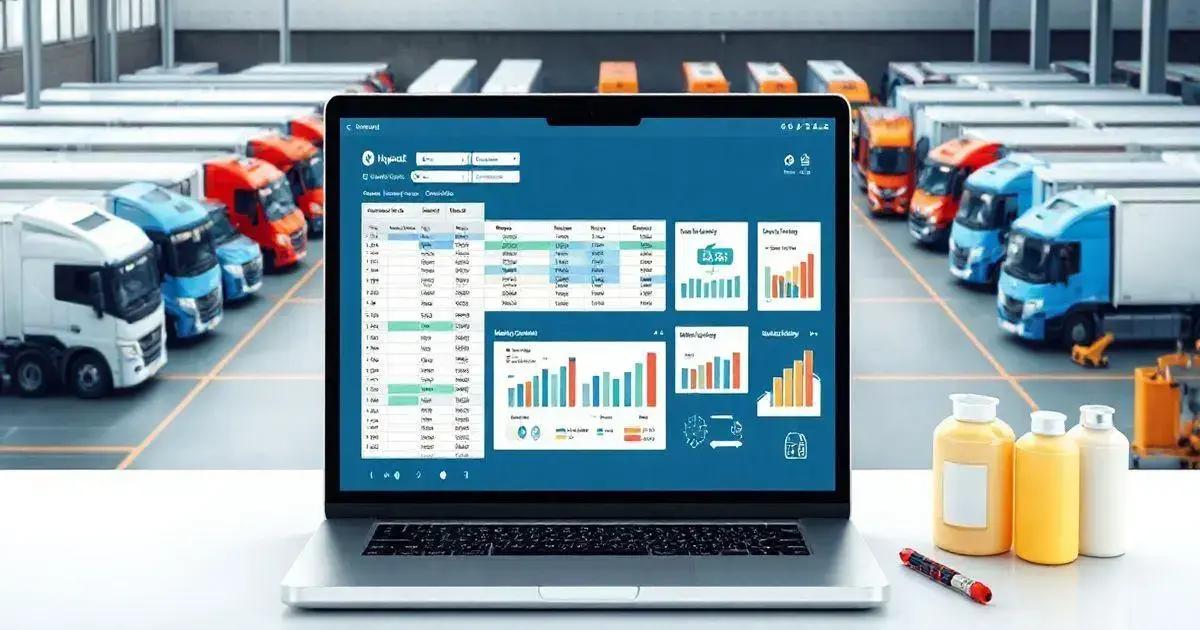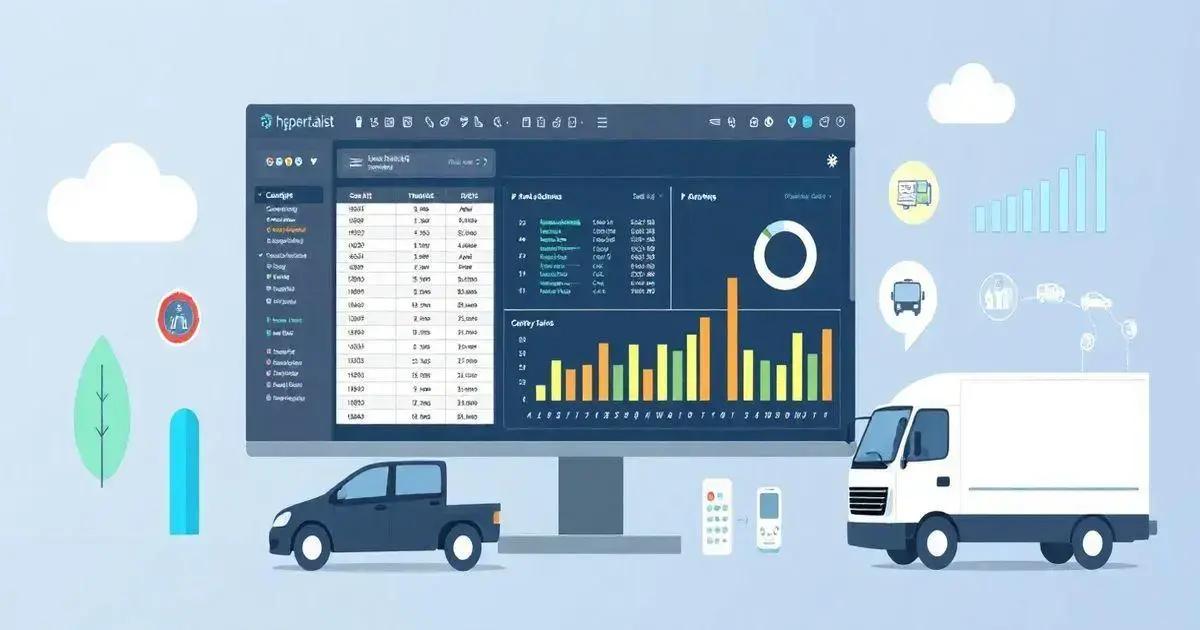10 Key Features of Fleet Control Worksheet 7.0 Leave a comment
The Fleet Control Worksheet 7.0 is a vital tool for fleet management, featuring an Initial Dashboard for performance tracking, Travel and Cargo Management for overseeing trips and loads, and Tire and Maintenance Control for vehicle safety. It includes a Document Management System for organizing documentation and a Cost Analysis and Reporting feature for financial insights, enabling fleet managers to optimize resources, enhance profitability, and uphold high operational standards.
Are you looking for a reliable solution to manage your fleet effectively? The Fleet Control Worksheet 7.0 is designed to help you keep track of your vehicles, maintenance schedules, fuel consumption, and more, all in one place. This comprehensive spreadsheet offers a user-friendly interface and powerful tools tailored for fleet management.
Overview of Fleet Control Worksheet 7.0
The Fleet Control Worksheet 7.0 is a robust tool designed specifically for fleet management, providing a comprehensive overview of all essential functions in a single, easy-to-use spreadsheet.
With this worksheet, you can efficiently manage and monitor various aspects of your fleet, ensuring optimal performance and cost-effectiveness.
One of the key features of this worksheet is its initial dashboard, which offers a visual representation of your fleet’s performance metrics such as fuel consumption, vehicle usage, and maintenance costs.
This means you can quickly assess how your fleet is performing without having to dig through multiple sheets or complex data sets.
Additionally, the worksheet includes sections dedicated to travel and cargo management, allowing you to keep track of trips, cargo loads, and any associated expenses.
This not only helps in ensuring that all trips are documented but also aids in analyzing cost efficiency over time.
Moreover, the Fleet Control Worksheet 7.0 comes equipped with features for tire control and maintenance tracking.
You can schedule routine maintenance, keep records of repairs, and even manage tire usage to ensure safety and performance are maintained across your fleet.
Ultimately, this worksheet stands out as a one-stop solution for fleet managers looking to streamline operations, reduce costs, and enhance productivity.
By using the Fleet Control Worksheet 7.0, fleet managers can ensure they have all the necessary tools at their fingertips to make informed decisions and improve overall fleet management.

Initial Dashboard Features
The Initial Dashboard of the Fleet Control Worksheet 7.0 is a powerful feature that provides a quick overview of your fleet’s performance at a glance. This dashboard is designed to simplify data analysis and facilitate informed decision-making. Here are some key features:
- KM by Driver: This metric allows you to track the distance each driver covers, helping identify high performers and those who may need additional training or support.
- KM per Vehicle: Monitor how much distance each vehicle travels, which aids in managing vehicle usage and identifying underutilized resources.
- KM per Liter: Calculate fuel efficiency by comparing kilometers driven with the liters of fuel consumed, enabling better management of fuel expenses.
- Average Consumption per Vehicle: This feature provides insights into the average fuel consumption of each vehicle, assisting in identifying potential maintenance issues or the need for fuel-efficient upgrades.
- Average Consumption per Driver: Track fuel consumption on a per-driver basis to spot trends and address any discrepancies in fuel usage among drivers.
- Total General Maintenance: Keep track of all maintenance activities, both preventive and corrective, to ensure that vehicles are running optimally and in compliance with safety standards.
- Maintenance Cost Average: This functionality gives you a snapshot of the average maintenance costs across your fleet, helping you budget effectively and make cost-saving decisions.
- Total Cost of Mechanical and Electrical Maintenance: Monitor expenses related to mechanical and electrical services, allowing for more accurate forecasting and cost control.
- Total Tire Maintenance Cost: Keep a handle on expenses related to tire maintenance, helping to ensure optimal performance and safety on the road.
- Total Lubricant Cost: Track the total costs associated with lubricants, essential for maintaining vehicle health and performance.
- Vehicles in Transit: Easily identify which vehicles are currently in transit to monitor operational efficiency and location tracking.
- Delayed Vehicle and Driver Documents: This feature helps manage compliance by keeping tabs on any overdue documents for vehicles and drivers, ensuring that all necessary paperwork is current.
- Delayed Preventive Maintenance: Stay proactive by tracking any overdue preventive maintenance tasks, ensuring that maintenance schedule adherence is maintained.
- Total Cost Versus Shipping: Analyze the total costs of your fleet operations in relation to shipping activities, helping you assess profitability and operational efficiency.
- Fuel, Maintenance, and Other Costs: This summary provides a comprehensive view of all costs associated with operating your fleet, allowing for better financial planning.
In summary, the Initial Dashboard of Fleet Control Worksheet 7.0 offers insightful metrics and data visualizations that empower fleet managers to make data-driven decisions. By leveraging these features, you can enhance operational efficiency, reduce costs, and optimize the overall management of your fleet.
Travel and Cargo Management
The Travel and Cargo Management section of the Fleet Control Worksheet 7.0 is designed to streamline the planning, tracking, and analysis of all trips taken by your fleet. This feature is crucial for ensuring that each journey is executed efficiently and that cargo is handled properly, optimizing both time and resources.
Cargo Control Linked to Trips: This feature allows you to connect each cargo load directly to its corresponding trip. By doing this, you can easily track what cargo is being transported, where it is going, and the expected delivery times. This linkage ensures that you have a clear view of all shipments and can manage logistics more effectively.
Vehicle Control: Manage which vehicles are assigned to which trips, providing insights into vehicle usage and availability. This functionality helps ensure that the right vehicle is always assigned to the right task based on capacity, fuel efficiency, and maintenance status.
Driver Control: Keep track of which drivers are assigned to each trip. Monitoring driver assignments helps ensure compliance with working hours and safety regulations, while also facilitating performance evaluations based on efficiency and feedback.
Supply Control: The worksheet allows you to manage and document all supplies needed for each trip. This feature enables you to keep an inventory of necessary materials and ensures that drivers have everything they need for their journeys, reducing delays and enhancing productivity.
Control of All Travel Expenses: Track all costs associated with each trip, including fuel, tolls, maintenance, and any unforeseen expenses. This comprehensive expense tracking enables better budgeting and financial oversight, allowing fleet managers to identify areas where savings can be made.
In essence, the Travel and Cargo Management feature of the Fleet Control Worksheet 7.0 provides fleet managers with a detailed overview and control of their operations. By efficiently managing trips and cargo, you can enhance logistical coordination, improve service delivery, and ultimately boost the profitability of your fleet.

Tire and Maintenance Control
The Tire and Maintenance Control section of the Fleet Control Worksheet 7.0 is essential for ensuring that your fleet operates safely and efficiently. Proper management of tires and maintenance activities not only prolongs the life of your vehicles but also optimizes performance and reduces unexpected breakdowns.
Identification for Each Tire: This feature allows you to assign a unique identification number to each tire on your fleet vehicles. By tracking tires individually, you can monitor their usage, performance, and history, which is vital for maintaining safety and reliability.
Tire Change Schedule by KM: The worksheet helps you establish a tire replacement schedule based on kilometers driven. By keeping track of mileage, you can ensure that tires are replaced at the appropriate intervals, enhancing safety and performance.
Signal of How Much KM is Left to Change the Tire: This functionality provides alerts when tires are nearing their replacement threshold. By monitoring remaining kilometers, you can proactively manage tire changes, preventing accidents or performance issues caused by worn-out tires.
Status per Action: Keep track of the status of each tire, including actions such as allocation to a vehicle, removal from a vehicle, scrapping, or maintenance. This feature ensures that you have a clear understanding of the lifecycle of each tire and can make informed decisions regarding tire management.
In addition to tire management, the worksheet provides comprehensive Maintenance Control features:
Corrective and Preventive Maintenance Type: You can categorize maintenance activities into corrective actions (repairs) and preventive maintenance schedules, which help keep vehicles in optimal condition.
Maintenance by Vehicle: Track maintenance activities for each vehicle individually. This allows for tailored maintenance schedules based on the specific needs and usage of each vehicle in the fleet.
Maintenance by Mechanical and Electrical Type, Tire and Lubricants: Manage and record maintenance activities related to mechanical and electrical systems, tires, and lubricants. This detailed reporting aids in ensuring that all aspects of vehicle health are addressed.
Maintenance Cost: The worksheet tracks costs associated with maintenance tasks, allowing fleet managers to analyze spending and identify potential savings.
Preventive Maintenance Schedule: Establish and adhere to a preventive maintenance schedule that automatically reminds you of upcoming tasks, helping to maintain vehicle performance and safety.
Preventive Maintenance Signal: Alerts when preventive maintenance is due or overdue, ensuring that no essential tasks are missed.
Status by: Scheduled, Accomplished, and Delayed: Keep track of the status of each maintenance task, ensuring that everything stays on schedule and that any delays are addressed promptly.
In conclusion, the Tire and Maintenance Control section of the Fleet Control Worksheet 7.0 provides a comprehensive framework for managing tire safety and vehicle maintenance. By utilizing these features, fleet managers can enhance operational efficiency, reduce costs, and ensure the safety of their drivers and vehicles.
Document Management System
The Document Management System in the Fleet Control Worksheet 7.0 is a vital feature designed to streamline the handling and tracking of important documentation related to your fleet operations. Efficient document management ensures compliance with regulations and improves organizational efficiency.
Driver Document Control: This feature allows you to maintain a comprehensive record of all documents related to each driver, including licenses, certifications, and training records. By tracking this information, you can ensure that all drivers are qualified and compliant with necessary regulations, reducing legal risks and enhancing safety.
Vehicle Document Control: Similar to driver documents, this functionality enables the management of all documentation for each vehicle in your fleet. This includes registration documents, insurance papers, and inspection certificates. Keeping these documents organized and easily accessible helps avoid potential fines or legal issues associated with non-compliance.
By implementing a robust Document Management System, the Fleet Control Worksheet 7.0 aids fleet managers in the following ways:
Improved Compliance: By regularly updating and checking the status of important documents, you can ensure that your fleet meets all local and national regulations, thereby avoiding penalties or operational disruptions.
Streamlined Operations: Having all necessary documents in one place allows for quicker access and retrieval, making operations more efficient and less time-consuming.
Audit Preparation: A well-maintained document management system simplifies the audit process by providing easy access to required documents, enabling a smoother and more transparent review process.
In summary, the Document Management System in the Fleet Control Worksheet 7.0 is a critical feature for ensuring that all driver and vehicle documentation is organized, compliant, and easily accessible. By utilizing this system, fleet managers can enhance operational efficiency, ensure regulatory compliance, and maintain a high standard of safety across the fleet.

Cost Analysis and Reporting
The Cost Analysis and Reporting feature in the Fleet Control Worksheet 7.0 is designed to provide fleet managers with a comprehensive overview of all expenses associated with fleet operations. Understanding and managing costs is crucial for optimizing budgets and improving profitability.
Total Cost Versus Shipping: This functionality allows you to analyze the total costs incurred by your fleet in relation to shipping activities. By comparing these figures, you can assess the profitability of each shipment and identify areas where cost savings can be achieved.
Fuel Costs Analysis: The worksheet enables detailed tracking of fuel expenses, including averages and comparisons against industry benchmarks. This feature helps identify trends in fuel consumption and can highlight inefficiencies, prompting strategies for improved fuel management.
Maintenance Costs Overview: Keep a tab on all maintenance-related expenses, both corrective and preventive. This overview assists in budgeting for future maintenance needs and helps in evaluating the overall cost-effectiveness of your fleet’s maintenance strategy.
Tire Maintenance Costs: Track expenses specifically related to tire maintenance. This information can guide decisions on purchasing new tires versus retreading existing ones, ultimately helping to manage tire-related costs more effectively.
Labor Costs: Analyze the labor costs associated with fleet operations, including driver salaries, overtime, and any additional payroll expenses. By understanding labor costs, fleet managers can optimize workforce deployment and improve overall operational efficiency.
Detailed Reporting: The worksheet generates detailed reports that summarize expenses across various categories, such as fuel, maintenance, labor, and others. These reports can be customized and exported for further analysis or presentation to stakeholders.
By leveraging the Cost Analysis and Reporting feature of the Fleet Control Worksheet 7.0, fleet managers can:
Identify Cost Overruns: Quickly identify any areas where costs exceed budgeted amounts, enabling timely corrective actions.
Enhance Budgeting Accuracy: Develop more accurate budgets based on historical expense data, which can lead to better financial planning.
Improve Decision-Making: Accessing comprehensive cost data supports informed decision-making regarding fleet management strategies and investments.
In conclusion, the Cost Analysis and Reporting feature of the Fleet Control Worksheet 7.0 empowers fleet managers to gain valuable insights into their operations, leading to cost-effective strategies, improved profitability, and enhanced overall fleet performance.
Conclusion
In summary, the Fleet Control Worksheet 7.0 is an indispensable tool for fleet managers seeking to optimize their operations.
With its comprehensive features covering tire and maintenance control, travel and cargo management, document management, and cost analysis, this worksheet provides all the necessary components to ensure a well-functioning fleet.
By utilizing the Initial Dashboard, fleet managers can quickly gain insights into vehicle performance, driver efficiency, and cost management.
The detailed tracking of maintenance and tire usage helps ensure safety and efficiency, while the document management system aids in compliance with regulations.
Additionally, the Cost Analysis and Reporting feature allows for informed decision-making and better financial oversight, making it easier to identify areas for improvement and savings.
Overall, Fleet Control Worksheet 7.0 not only enhances operational efficiency but also contributes to the long-term success of your fleet management strategy.
For fleet managers looking to streamline their processes and boost productivity, investing in the Fleet Control Worksheet 7.0 is a smart choice that promises significant returns.
FAQ – Frequently Asked Questions about Fleet Control Worksheet 7.0
What is the purpose of the Fleet Control Worksheet 7.0?
The Fleet Control Worksheet 7.0 is designed to help fleet managers efficiently track and manage various aspects of their fleet operations, including vehicle performance, maintenance schedules, and cost analysis.
How does the Initial Dashboard feature work?
The Initial Dashboard provides a visual overview of key performance metrics such as kilometers driven, fuel consumption, and maintenance costs, allowing fleet managers to quickly assess fleet performance.
Can I track individual tires with this worksheet?
Yes, the Tire and Maintenance Control section allows you to assign unique identifiers to each tire, track their usage, and schedule replacements based on kilometers driven.
What types of documents can I manage with the Document Management System?
You can manage various documents related to drivers and vehicles, including licenses, insurance papers, and inspection certificates, ensuring compliance and easy access to important information.
How does the Cost Analysis feature help with budgeting?
The Cost Analysis feature tracks and categorizes all expenses related to fleet operations, enabling fleet managers to identify cost overruns, enhance budgeting accuracy, and make informed financial decisions.
Is the Fleet Control Worksheet user-friendly for new users?
Yes, the Fleet Control Worksheet 7.0 is designed with a user-friendly interface that simplifies navigation and data entry, making it accessible for users of all experience levels.

